




Natural Resources

Nancy Creek runs through DeKalb and Fulton Co. It flows from above Doraville southwesterly into Peachtree Creek just before it enters the Chattahoochee River. Possibly named by Mr. John L. Evins after his wife Nancy in 1824 as a name for a church nearby. The name Nancy was first recorded in the now Fulton, then DeKalb county by the states surveyor in 1821, and was thought to be named after an Indian woman who lived in the area.
The Mean Elevation of the state of Georgia is
600 ft. above sea level.
Ga. covers 59,441 sq. miles,
making it the 24th largest of the 50 states.
Land area -- 57,919 miles
Water area -- 1,522 sq. miles
Ga. is 300 miles long and 230 miles wide
Atlanta is about 1050 ft. above Mean Sea Level.
It sits atop a ridge south of the Chattahoochee River.
Atlanta is the third highest city, slightly lower than Phoenix.
Atlanta covers 132.4 miles
Land area -- 131.8 miles
Water area -- .7 miles
At least 12 species of pine trees, genus Pinus, are found in Ga., and these trees are undoubtedly the most prominent and valuable. Forests cover two thirds of the state and pines comprise 47% of this coverage.
Piedmont Region is the name applied to the broken and hilly
land lying between the Appalachian Mountains of N. Ga.
and the Atlantic Coastal Plains. Piedmont is a French term
which originated from the Italian word piedmonte, meaning
“foot hills” or “foot of the mountain.”



A Pecan Grove
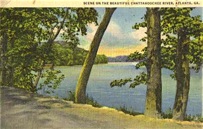
Chattahoochee River Atlanta Ga.
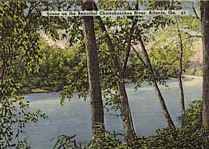
Chattahoochee River Atlanta Ga.
In any season, the Chattahoochee banks are resplendent in color.
Trout lilies, serviceberry, and redbuds bloom in early spring followed by azaleas, trillium and coreopsis.
Late summer, cardinal flowers and the showy scarlet sumacs turn brilliant shades of red with the yellows of goldenrod, the deep purple of ironwood and the multitude of foliage of fall’s changing leaves.
 The region along the Chattahoochee River is facing environmental factors like air quality, drought, and invasive, nonnative plants. Mimosa trees, Princess trees, bamboo, kudzu, and privet are a few of the exotic plants. These plants use the nutrients in the soil and take up space that belongs to the native plants. The problem is the exotic plants do not provide the proper food and nutrients for the native wildlife. The diverse native flora is lost to a few non-native species.
The region along the Chattahoochee River is facing environmental factors like air quality, drought, and invasive, nonnative plants. Mimosa trees, Princess trees, bamboo, kudzu, and privet are a few of the exotic plants. These plants use the nutrients in the soil and take up space that belongs to the native plants. The problem is the exotic plants do not provide the proper food and nutrients for the native wildlife. The diverse native flora is lost to a few non-native species.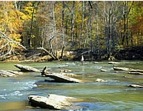

On the Chattahoochee River, just upstream of Atlanta Road at the Atlanta water works intake, is rapids that are a popular slalom training area. The rapids are Class ll ( lll ), for 0.2 miles.
There is parking on Atlanta Road at the Chattahoochee bridge, on the south side of the river. Walk down the path on the Fulton Co. side to the Rail to Trails bike path. Just past the trestle the bike path veers to the right. There is a dirt path that veers to the left, that goes down to the “ beach” where Nancy Creek enters into the Chattahoochee. From there the rapids are about a 100 ft. paddle up river.
The Chattahoochee River is called the ‘Hooch’ by locals. The river below Buford Dam is not a native trout fishery. This artificially created fishery is the only trout water in the Atlanta area. River temperatures range between 52 and 58 degrees the majority of the year. During winter months temperatures drop into the 40’s resulting in slow fishing. “Hot Atlanta” summer months raises the water to the point that trout cannot survive unless they can find a cool underwater spring flowing into the river.
Officially the “ Hooch “ is the southern most trout water in the U. S. Very little trout reproduction takes place below Buford Dam, due to siltation and lack of available habitat protection.
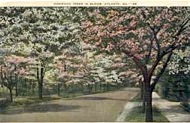
Dogwoods in Bloom
Atlanta Ga.
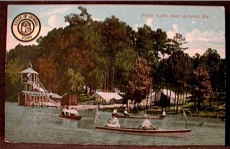
Silver Lake near Atlanta Ga.

Kennasaw Mountain
The Chattahoochee River Basin is home to 9 state threatened or endangered plant species.
The city of Atlanta, in 2000, was forced by a federal consent, to clean up the streams that feed into the Chattahoochee River. 568 tons of trash, and 7 automobiles were removed from these streams.
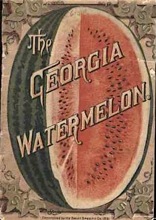
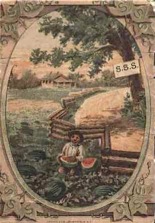
Trade Card - Swift Specific Co. Atlanta Georgia
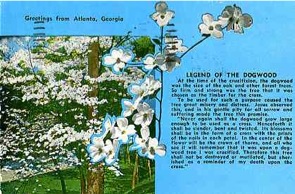
Legend of the Dogwood
At the time of the crucifiction, the dogwood
was the size of the oak and other forest trees.
So firm and strong was the tree that it was
chosen as the timber for the cross.
To be used for such a purpose caused the
tree great misery and distress. Jesus observed
this, and in his gentle pity for all sorrow and
suffering made the tree this promise.
“Never again shall the dogwood grow large
enough to be used as a cross. Henceforth it
shall be slender, bent and twisted. It’s blossoms
shall be in the form of a cross with the prints
of the nails in each petal. In the center of the flower will be the crown of thorns, and all who see it will remember that it was upon a dogwood
tree I was crucified. Therefore this tree
shall not be destroyed or mutilated, but cherished
as a reminder of my death upon the cross.”
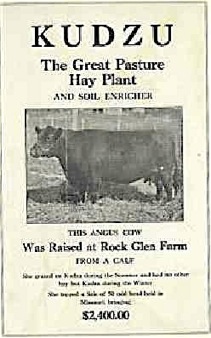
Kudzu
The Great Pasture
Hay Plant
And Soil Enricher
This Angus Cow
Was Raised at Rock Glen Farm
From A Calf
She grazed on Kudzu during the Summer
and had no other hay but Kudzu
during the Winter.
Kudzu Advertisement 1938
Rock Glen Farm, Atlanta Ga.
"The Great Pasture Hay Plant and Soil Enricher"
100 kudzu plants could be purchased for $6.
1000 for $40.
Now several states are spending vast
amounts to get rid of it.
Gator Spotted in Chattahoochee
Atlanta Ga. June 12, 2007
A 6 to 7 foot alligator was found at the Chattahoochee River at I-285 at the Fulton - Cobb County line. Officials say it is extremely rare to see an alligator in N. Georgia. Usually they stay well below the fall line in Macon.
There are approximately 250,000 alligators in Ga. In the past 20 years in Ga. there have been only six attacks on humans and none were fatal.

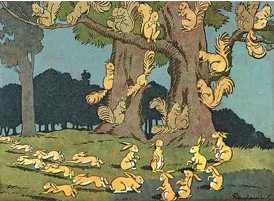

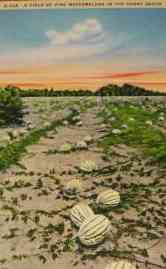
Field of Fine Watermelons in the Sunny South
Postcard 1930s
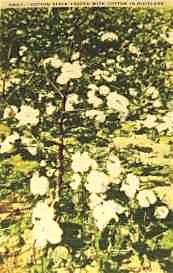
Cotton Stalk
Loaded with Cotton
Postcard 1930s


